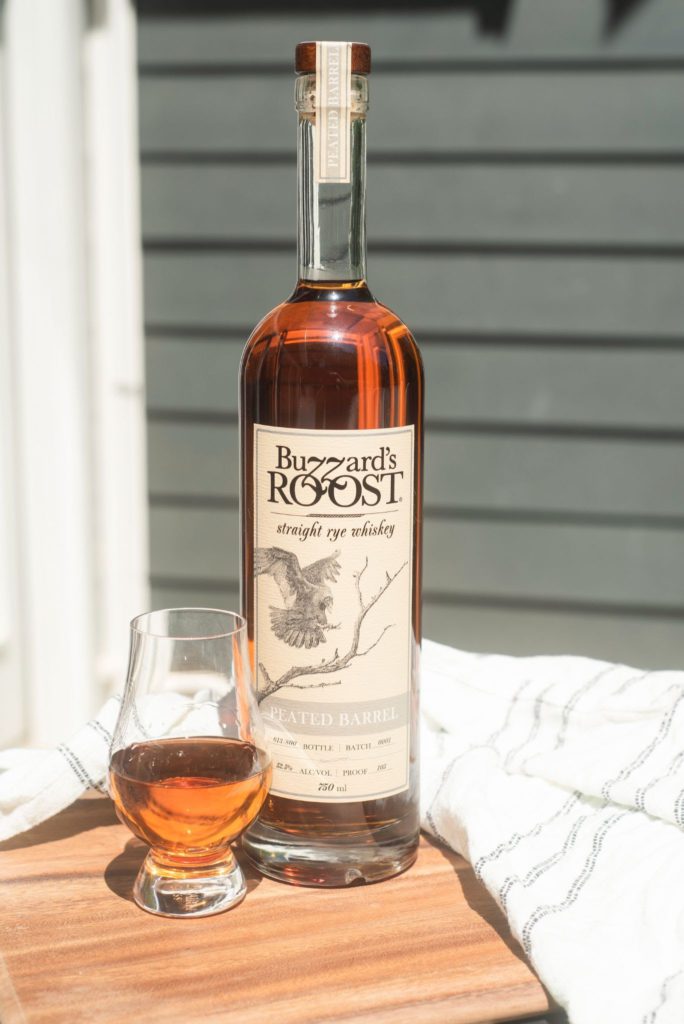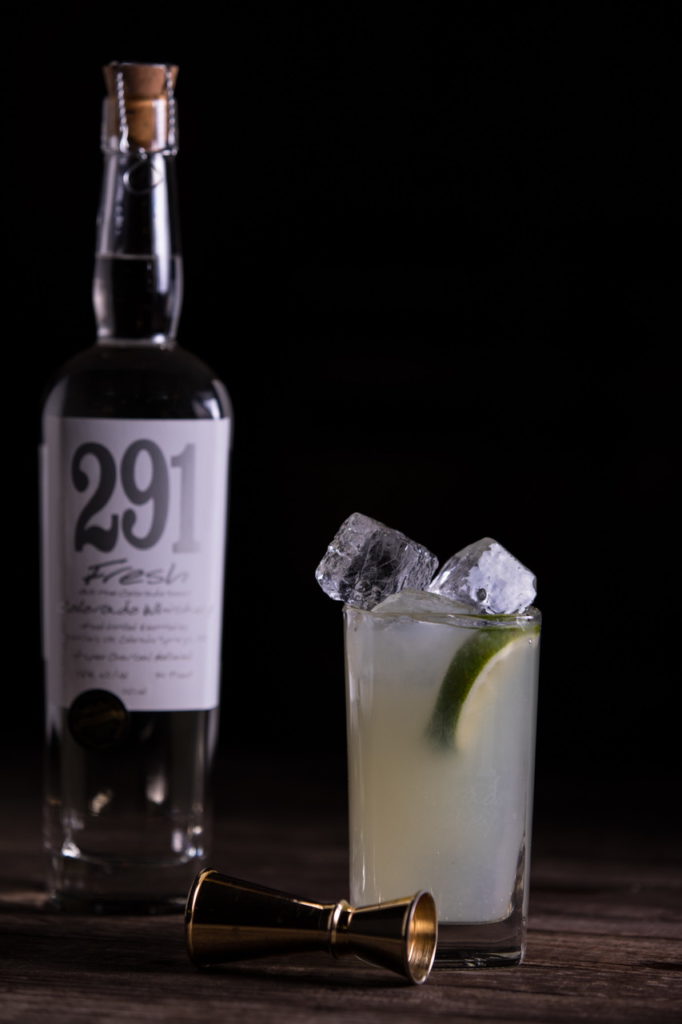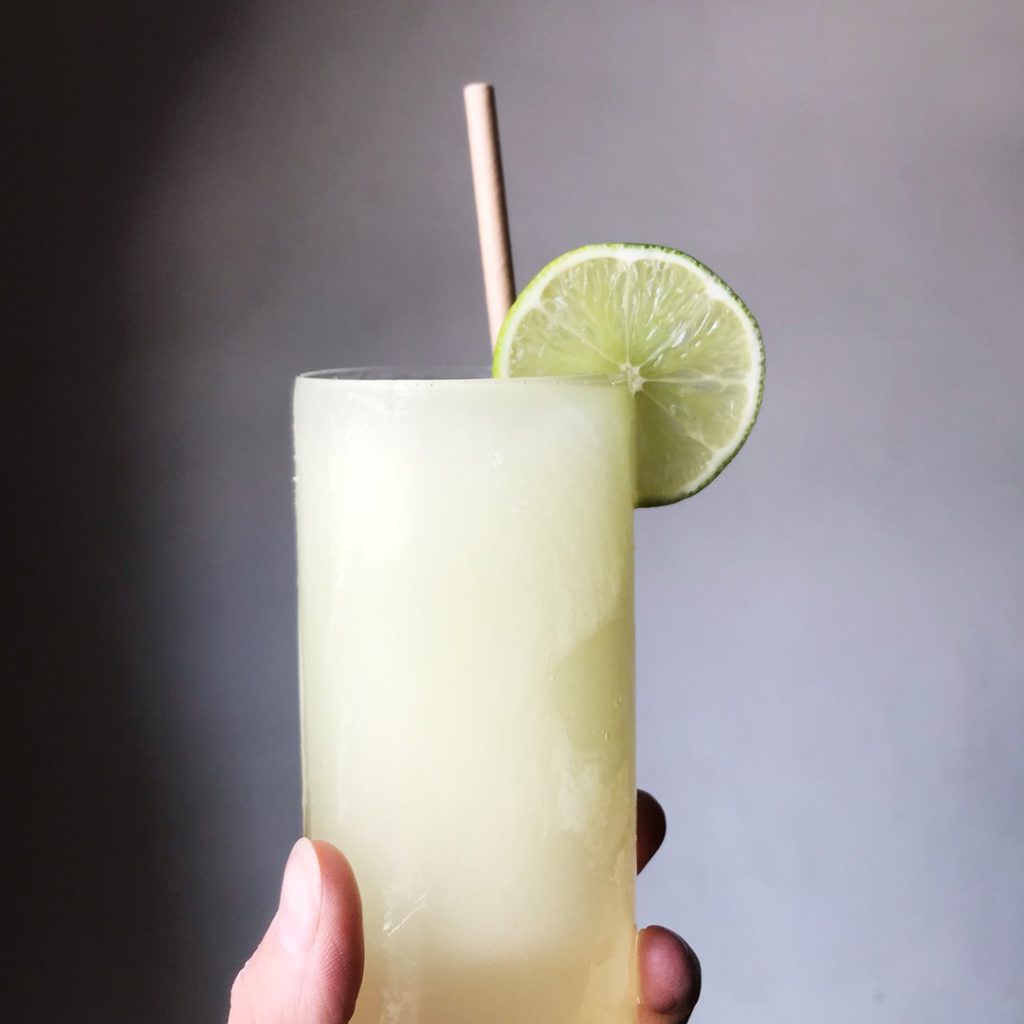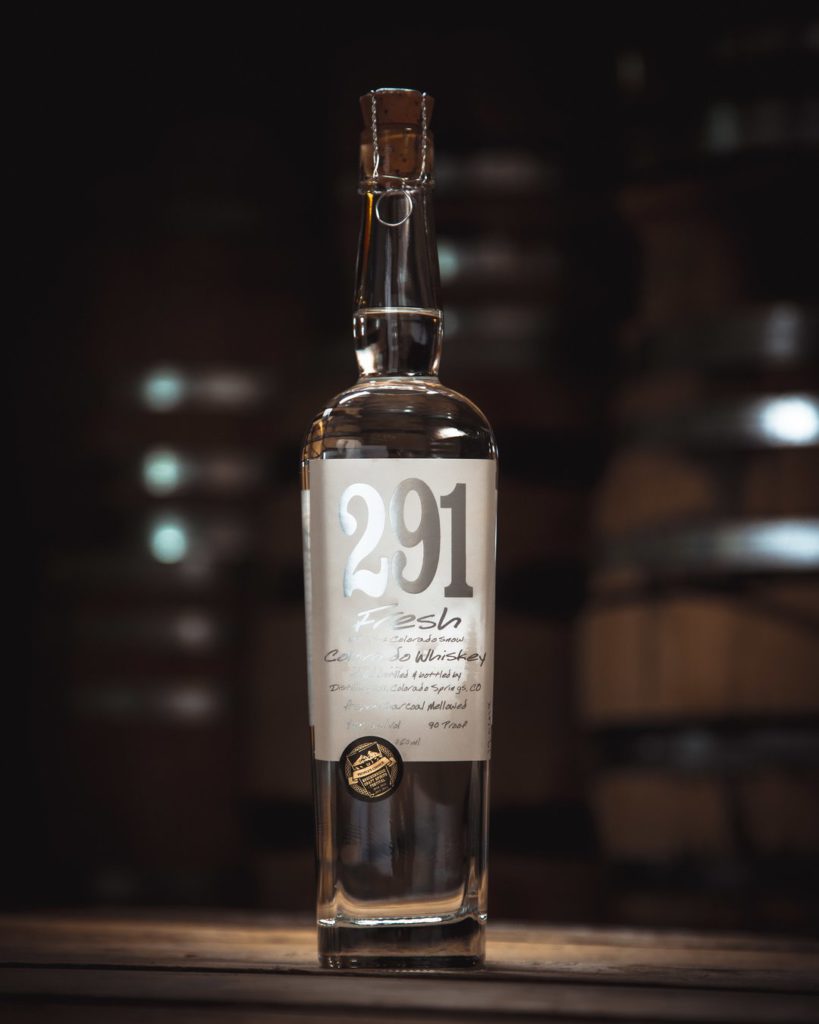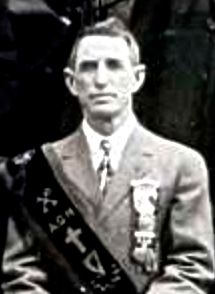 Calling himself a professional “rectifier,” i.e. expert blender of whiskey, and frequently employed by his fellow Texans to determine the quality and composition of liquor, Gilbert Ryan O’Shaugnessy as a youth had taken a pledge never to drink alcohol. According to family lore, what Gilbert, shown here, tasted he spit out — just one aspect of the unusual life of this Irish immigrant.
Calling himself a professional “rectifier,” i.e. expert blender of whiskey, and frequently employed by his fellow Texans to determine the quality and composition of liquor, Gilbert Ryan O’Shaugnessy as a youth had taken a pledge never to drink alcohol. According to family lore, what Gilbert, shown here, tasted he spit out — just one aspect of the unusual life of this Irish immigrant.
Gilbert was born in July 1858 in Slievedooly, County Clare, the son of Patrick and Mary Ryan O’Shaughnessy. His mother died when Gilbert was only two and the boy received an elementary education in Ireland. It was in Ireland that he took the temperance pledge that he honored all his life. His father was a dairy farmer whose properties by custom would go to an elder son. As a younger son, Gilbert faced a less fortunate future, possibly the impetus for him to immigrate to America.
Sources differ between 1878 and 1883 as the year the youthful Gilbert arrived on these shores. He seems early to have settled in Galveston, Texas. There he met Mary Hansbury, born in Texas, the daughter of Irish immigrants, Mary Anne and Michael Hansbury, At the time of their marriage in February 1887, Gilbert was 29 and Mary 22.
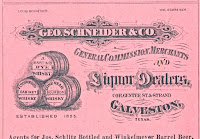 During Gilbert’s decade or so living in Galveston, he worked for George Schneider & Co., whose letterhead proclaimed the business as “General Commission Merchants and Liquor Dealers.” The Irishman’s status as a non-drinker might have helped him secure the job. Gilbert seems to have been a highly useful employee, listed initially in Galveston directories as a “drayman,” that is, driving a horse-drawn wagon, and subsequently employed as a clerk. Gilbert also had skills in cooperage, making barrels for holding Schneider’s house whiskey blends that included “Lone Star Bourbon” and “J. Martin Rye.”
During Gilbert’s decade or so living in Galveston, he worked for George Schneider & Co., whose letterhead proclaimed the business as “General Commission Merchants and Liquor Dealers.” The Irishman’s status as a non-drinker might have helped him secure the job. Gilbert seems to have been a highly useful employee, listed initially in Galveston directories as a “drayman,” that is, driving a horse-drawn wagon, and subsequently employed as a clerk. Gilbert also had skills in cooperage, making barrels for holding Schneider’s house whiskey blends that included “Lone Star Bourbon” and “J. Martin Rye.”
 As his employment with Schneider & Co. progressed, Gilbert became increasingly involved in the wholesaling, retailing and finally manufacture of whiskey. In 1901 he listed his occupation as “rectifier” for the firm. Rectifying or blending whiskey was and still is a highly valued skill in the liquor industry. It requires the ability to insure consistency over time in the taste, smoothness and color in a particular brand. Shown here is a Scheider quart.
As his employment with Schneider & Co. progressed, Gilbert became increasingly involved in the wholesaling, retailing and finally manufacture of whiskey. In 1901 he listed his occupation as “rectifier” for the firm. Rectifying or blending whiskey was and still is a highly valued skill in the liquor industry. It requires the ability to insure consistency over time in the taste, smoothness and color in a particular brand. Shown here is a Scheider quart.
Just as Gilbert was reaching the pinnacle of skilled whiskey men, tragedy befell the O’Shaugnessys. During their decade in Galveston their union had produced five children, Mary Gertrude, Katherine, Patrick, Margaret Eileen, and Antoinette. On September 8, 1900, a hurricane struck Galveston considered to be the deadliest natural disaster in American history, killing an estimated 8,000 persons.
 As Gulf waters inundated the city, a crowd of forty or more displaced residents crowded into the O’Shaughnessy residence, waiting on the second floor for rescue. When a boat at last arrived, the rush to board caused the craft to overturn temporarily. Antoinette, 5 years old, was swept away by the flood waters. Fortunately, Gilbert, Mary, and their four remaining children were saved.My grandfather searched for her for two weeks,” related one descendant about Antoinette. When Gilbert at last found her body amid the acres of wreckage, they buried her in Galveston and shortly after moved 250 miles west to San Antonio. “I do not believe they ever got over the horror of that storm.”
As Gulf waters inundated the city, a crowd of forty or more displaced residents crowded into the O’Shaughnessy residence, waiting on the second floor for rescue. When a boat at last arrived, the rush to board caused the craft to overturn temporarily. Antoinette, 5 years old, was swept away by the flood waters. Fortunately, Gilbert, Mary, and their four remaining children were saved.My grandfather searched for her for two weeks,” related one descendant about Antoinette. When Gilbert at last found her body amid the acres of wreckage, they buried her in Galveston and shortly after moved 250 miles west to San Antonio. “I do not believe they ever got over the horror of that storm.”

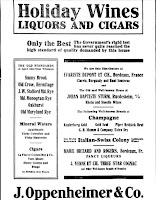 In San Antonio, shown above in 1910, Gilbert soon found employment with J. Oppenheimer & Co., a local grocery and liquor wholesaler and retailer located at 230 West Commerce Street. “This firm handles the finest wines and liquors to be had anywhere, both imported and domestic,” gushed a puff piece in the San Antonio Light. A company ad indicates that while Oppenheimer was selling national brands like “Sunny Brook.” “Old Crow,” and “Hermitage,” it also featured house brands like “J.W. Stafford Maryland Rye,” “Maryland Monogram Rye.” and “Oakhurst Whiskey.”
In San Antonio, shown above in 1910, Gilbert soon found employment with J. Oppenheimer & Co., a local grocery and liquor wholesaler and retailer located at 230 West Commerce Street. “This firm handles the finest wines and liquors to be had anywhere, both imported and domestic,” gushed a puff piece in the San Antonio Light. A company ad indicates that while Oppenheimer was selling national brands like “Sunny Brook.” “Old Crow,” and “Hermitage,” it also featured house brands like “J.W. Stafford Maryland Rye,” “Maryland Monogram Rye.” and “Oakhurst Whiskey.”
Oppenheimer’s ads claimed: “The Government’s rigid test has never quite reached the high standard of quality demanded by this house.” Such a boast suggests that the company required the services of a professional rectifier such as Gilbert. In order for their house brands to achieve quality desired, his services would be needed at every step to guide the results. For Gilbert it meant tasting and spitting out literally gallons of whiskey over his lifetime.
A skilled rectifier like Gilbert was also called upon by San Antonio liquor dealers and saloonkeepers to test by taste the whiskeys they were purchasing. Some unscrupulous distillers and wholesalers sold products that were watered down or contained ingredients including grain alcohol, fusel oils, tobacco juice, molasses, and artificial coloring. A professional taster could detect such contaminants. In the 1900 federal census Gilbert gave his occupation simply as “rectifier,” in the liquor industry. No specific employer was indicated.
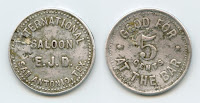 As time went on, while continuing to work with Oppenheimer, Gilbert was associating closely with several San Antonio drinking establishments, reported among them the Viaduct Bar and the International Saloon. Shown here are two sides of a bar token from the latter. Apparently moving from selling whiskey by the bottle to selling it by the glass, Gilbert was obliged to acquire the skills of bartender and saloonkeeper.
As time went on, while continuing to work with Oppenheimer, Gilbert was associating closely with several San Antonio drinking establishments, reported among them the Viaduct Bar and the International Saloon. Shown here are two sides of a bar token from the latter. Apparently moving from selling whiskey by the bottle to selling it by the glass, Gilbert was obliged to acquire the skills of bartender and saloonkeeper.
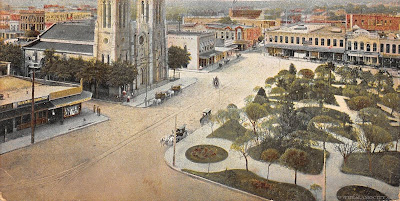

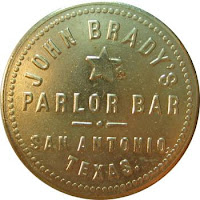 He apparently liked the change. In 1913 the Irishman became proprietor of the Brady Parlor Bar at 106 East Main Plaza, in the shadow of the city’s Catholic Cathedral, shown above. It was named for James T. Brady who turned it over to Gilbert’s management in 1913. This was a high class saloon, known as the sole Texas agent for “Old Ripy,” a quality Kentucky bourbon. O’Shaughnessy’s business card stated: “We keep only One Brand and One Brand only for all customers — for Home use, Medicinal Purposes, and over the Bar.” The “Teetotaler Taster” operated the establishment until shut down by National Prohibition in 1919.
He apparently liked the change. In 1913 the Irishman became proprietor of the Brady Parlor Bar at 106 East Main Plaza, in the shadow of the city’s Catholic Cathedral, shown above. It was named for James T. Brady who turned it over to Gilbert’s management in 1913. This was a high class saloon, known as the sole Texas agent for “Old Ripy,” a quality Kentucky bourbon. O’Shaughnessy’s business card stated: “We keep only One Brand and One Brand only for all customers — for Home use, Medicinal Purposes, and over the Bar.” The “Teetotaler Taster” operated the establishment until shut down by National Prohibition in 1919.
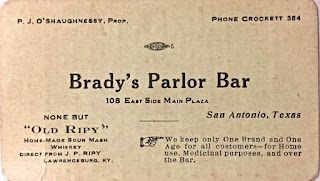
Whiskey, however, was only one aspect of Gilbert O’Shaugnessy’s life. He became a well known and respected member of the Irish-American community in San Antonio. In 1908 he was elected president of the local chapter of the Ancient Order of Hibernians, an Irish social organization. The picture of Gilbert that opens this post is taken from a group photo of the Hibernians arrayed in front of St. Mary’s Catholic Church after the annual St. Patrick’s Day Mass. The members were wearing their sashes and badges. Gilbert was the only one in a light suit and one of the few who was clean shaven. He is also visible far left below standing on the running board of an automobile in the ensuing St.Patrick’s parade in downtown San Antonio. Although Gilbert owned a motor car, the former drayman as yet did not know how to drive.
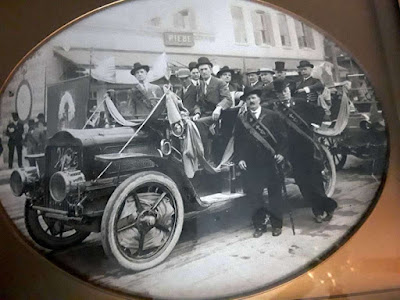
Typically on St. Patrick’s Day the Hibernian’s planned a daylong celebration for the patron saint of Ireland. The Mass and parade would be followed by an elaborate dinner in which with the ladies auxiliary, the Daughters of Erin, and others, including the German American Liederkranz, performed skits and musical numbers. Says one writer: “Often the grand finale on the evening’s vaudeville-style was Gilbert O’Shaughnessy, whose Irish dancing brought down the house.” In contrast to vaunted Irish tenors, Gilbert was reputed to be unable to carry a tune.
O’Shaughnessy was a devoted family man, according to a descendant: “His children and grandchildren grew up to find good jobs, wore the uniform of this country in wartime, were called to the religious life.” Gilbert Jr.became a highly successful West Coast jazz musician and another son was an international golf champion. The family had realized the promise of America that brought Gilbert to these shores.
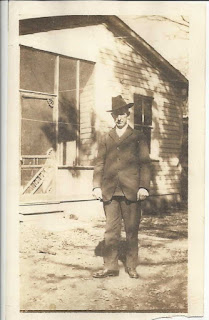 With the advent of National Prohibition, Gilbert was forced to shut down his saloon. Now 62, he took a job with the San Antonio Parks Department. As a city employee, he began a 12-year career as an inspector and later, having taught himself to drive, as a chauffeur. Shown here In his later years, Gilbert was diagnosed with stomach cancer in July 1932 and died four months later on October 31— the eve of All Saints’ Day. As shown here, he was buried in San Antonio’s San Fernando cemetery.
With the advent of National Prohibition, Gilbert was forced to shut down his saloon. Now 62, he took a job with the San Antonio Parks Department. As a city employee, he began a 12-year career as an inspector and later, having taught himself to drive, as a chauffeur. Shown here In his later years, Gilbert was diagnosed with stomach cancer in July 1932 and died four months later on October 31— the eve of All Saints’ Day. As shown here, he was buried in San Antonio’s San Fernando cemetery.
At his funeral the Gilbert O’Shaughnessy was extolled for his generosity to the needy and other good works entitling him, said the priest, “to walk among the princes of the people.” Little was said about his three decades working in virtually every aspect of the liquor trade, but once sworn having to abstain from alcohol, never having taken a drink himself, demonstrating a strength of character given to very few.
Notes: Much of this article was derived from two columns in the San Antonio Express-News in March and April 2021 written by Paula Allen. The first column was sparked by an inquiry from an O’Shaughnessy descendant who asked whether “rectifier” was a genuine occupation. It was followed by a second column that focused on Gilbert’s career. Family photographs are also from that source.
 Calling himself a professional “rectifier,” i.e. expert blender of whiskey, and frequently employed by his fellow Texans to determine the quality and composition of liquor, Gilbert Ryan O’Shaugnessy as a youth had taken a pledge never to drink alcohol. According to family lore, what Gilbert, shown here, tasted he spit out — just one aspect of the unusual life of this Irish immigrant.
Calling himself a professional “rectifier,” i.e. expert blender of whiskey, and frequently employed by his fellow Texans to determine the quality and composition of liquor, Gilbert Ryan O’Shaugnessy as a youth had taken a pledge never to drink alcohol. According to family lore, what Gilbert, shown here, tasted he spit out — just one aspect of the unusual life of this Irish immigrant.
Gilbert was born in July 1858 in Slievedooly, County Clare, the son of Patrick and Mary Ryan O’Shaughnessy. His mother died when Gilbert was only two and the boy received an elementary education in Ireland. It was in Ireland that he took the temperance pledge that he honored all his life. His father was a dairy farmer whose properties by custom would go to an elder son. As a younger son, Gilbert faced a less fortunate future, possibly the impetus for him to immigrate to America.
Sources differ between 1878 and 1883 as the year the youthful Gilbert arrived on these shores. He seems early to have settled in Galveston, Texas. There he met Mary Hansbury, born in Texas, the daughter of Irish immigrants, Mary Anne and Michael Hansbury, At the time of their marriage in February 1887, Gilbert was 29 and Mary 22.
 During Gilbert’s decade or so living in Galveston, he worked for George Schneider & Co., whose letterhead proclaimed the business as “General Commission Merchants and Liquor Dealers.” The Irishman’s status as a non-drinker might have helped him secure the job. Gilbert seems to have been a highly useful employee, listed initially in Galveston directories as a “drayman,” that is, driving a horse-drawn wagon, and subsequently employed as a clerk. Gilbert also had skills in cooperage, making barrels for holding Schneider’s house whiskey blends that included “Lone Star Bourbon” and “J. Martin Rye.”
During Gilbert’s decade or so living in Galveston, he worked for George Schneider & Co., whose letterhead proclaimed the business as “General Commission Merchants and Liquor Dealers.” The Irishman’s status as a non-drinker might have helped him secure the job. Gilbert seems to have been a highly useful employee, listed initially in Galveston directories as a “drayman,” that is, driving a horse-drawn wagon, and subsequently employed as a clerk. Gilbert also had skills in cooperage, making barrels for holding Schneider’s house whiskey blends that included “Lone Star Bourbon” and “J. Martin Rye.”
 As his employment with Schneider & Co. progressed, Gilbert became increasingly involved in the wholesaling, retailing and finally manufacture of whiskey. In 1901 he listed his occupation as “rectifier” for the firm. Rectifying or blending whiskey was and still is a highly valued skill in the liquor industry. It requires the ability to insure consistency over time in the taste, smoothness and color in a particular brand. Shown here is a Scheider quart.
As his employment with Schneider & Co. progressed, Gilbert became increasingly involved in the wholesaling, retailing and finally manufacture of whiskey. In 1901 he listed his occupation as “rectifier” for the firm. Rectifying or blending whiskey was and still is a highly valued skill in the liquor industry. It requires the ability to insure consistency over time in the taste, smoothness and color in a particular brand. Shown here is a Scheider quart.
Just as Gilbert was reaching the pinnacle of skilled whiskey men, tragedy befell the O’Shaugnessys. During their decade in Galveston their union had produced five children, Mary Gertrude, Katherine, Patrick, Margaret Eileen, and Antoinette. On September 8, 1900, a hurricane struck Galveston considered to be the deadliest natural disaster in American history, killing an estimated 8,000 persons.
 As Gulf waters inundated the city, a crowd of forty or more displaced residents crowded into the O’Shaughnessy residence, waiting on the second floor for rescue. When a boat at last arrived, the rush to board caused the craft to overturn temporarily. Antoinette, 5 years old, was swept away by the flood waters. Fortunately, Gilbert, Mary, and their four remaining children were saved.My grandfather searched for her for two weeks,” related one descendant about Antoinette. When Gilbert at last found her body amid the acres of wreckage, they buried her in Galveston and shortly after moved 250 miles west to San Antonio. “I do not believe they ever got over the horror of that storm.”
As Gulf waters inundated the city, a crowd of forty or more displaced residents crowded into the O’Shaughnessy residence, waiting on the second floor for rescue. When a boat at last arrived, the rush to board caused the craft to overturn temporarily. Antoinette, 5 years old, was swept away by the flood waters. Fortunately, Gilbert, Mary, and their four remaining children were saved.My grandfather searched for her for two weeks,” related one descendant about Antoinette. When Gilbert at last found her body amid the acres of wreckage, they buried her in Galveston and shortly after moved 250 miles west to San Antonio. “I do not believe they ever got over the horror of that storm.”

 In San Antonio, shown above in 1910, Gilbert soon found employment with J. Oppenheimer & Co., a local grocery and liquor wholesaler and retailer located at 230 West Commerce Street. “This firm handles the finest wines and liquors to be had anywhere, both imported and domestic,” gushed a puff piece in the San Antonio Light. A company ad indicates that while Oppenheimer was selling national brands like “Sunny Brook.” “Old Crow,” and “Hermitage,” it also featured house brands like “J.W. Stafford Maryland Rye,” “Maryland Monogram Rye.” and “Oakhurst Whiskey.”
In San Antonio, shown above in 1910, Gilbert soon found employment with J. Oppenheimer & Co., a local grocery and liquor wholesaler and retailer located at 230 West Commerce Street. “This firm handles the finest wines and liquors to be had anywhere, both imported and domestic,” gushed a puff piece in the San Antonio Light. A company ad indicates that while Oppenheimer was selling national brands like “Sunny Brook.” “Old Crow,” and “Hermitage,” it also featured house brands like “J.W. Stafford Maryland Rye,” “Maryland Monogram Rye.” and “Oakhurst Whiskey.”
Oppenheimer’s ads claimed: “The Government’s rigid test has never quite reached the high standard of quality demanded by this house.” Such a boast suggests that the company required the services of a professional rectifier such as Gilbert. In order for their house brands to achieve quality desired, his services would be needed at every step to guide the results. For Gilbert it meant tasting and spitting out literally gallons of whiskey over his lifetime.
A skilled rectifier like Gilbert was also called upon by San Antonio liquor dealers and saloonkeepers to test by taste the whiskeys they were purchasing. Some unscrupulous distillers and wholesalers sold products that were watered down or contained ingredients including grain alcohol, fusel oils, tobacco juice, molasses, and artificial coloring. A professional taster could detect such contaminants. In the 1900 federal census Gilbert gave his occupation simply as “rectifier,” in the liquor industry. No specific employer was indicated.
 As time went on, while continuing to work with Oppenheimer, Gilbert was associating closely with several San Antonio drinking establishments, reported among them the Viaduct Bar and the International Saloon. Shown here are two sides of a bar token from the latter. Apparently moving from selling whiskey by the bottle to selling it by the glass, Gilbert was obliged to acquire the skills of bartender and saloonkeeper.
As time went on, while continuing to work with Oppenheimer, Gilbert was associating closely with several San Antonio drinking establishments, reported among them the Viaduct Bar and the International Saloon. Shown here are two sides of a bar token from the latter. Apparently moving from selling whiskey by the bottle to selling it by the glass, Gilbert was obliged to acquire the skills of bartender and saloonkeeper.


 He apparently liked the change. In 1913 the Irishman became proprietor of the Brady Parlor Bar at 106 East Main Plaza, in the shadow of the city’s Catholic Cathedral, shown above. It was named for James T. Brady who turned it over to Gilbert’s management in 1913. This was a high class saloon, known as the sole Texas agent for “Old Ripy,” a quality Kentucky bourbon. O’Shaughnessy’s business card stated: “We keep only One Brand and One Brand only for all customers — for Home use, Medicinal Purposes, and over the Bar.” The “Teetotaler Taster” operated the establishment until shut down by National Prohibition in 1919.
He apparently liked the change. In 1913 the Irishman became proprietor of the Brady Parlor Bar at 106 East Main Plaza, in the shadow of the city’s Catholic Cathedral, shown above. It was named for James T. Brady who turned it over to Gilbert’s management in 1913. This was a high class saloon, known as the sole Texas agent for “Old Ripy,” a quality Kentucky bourbon. O’Shaughnessy’s business card stated: “We keep only One Brand and One Brand only for all customers — for Home use, Medicinal Purposes, and over the Bar.” The “Teetotaler Taster” operated the establishment until shut down by National Prohibition in 1919.

Whiskey, however, was only one aspect of Gilbert O’Shaugnessy’s life. He became a well known and respected member of the Irish-American community in San Antonio. In 1908 he was elected president of the local chapter of the Ancient Order of Hibernians, an Irish social organization. The picture of Gilbert that opens this post is taken from a group photo of the Hibernians arrayed in front of St. Mary’s Catholic Church after the annual St. Patrick’s Day Mass. The members were wearing their sashes and badges. Gilbert was the only one in a light suit and one of the few who was clean shaven. He is also visible far left below standing on the running board of an automobile in the ensuing St.Patrick’s parade in downtown San Antonio. Although Gilbert owned a motor car, the former drayman as yet did not know how to drive.

Typically on St. Patrick’s Day the Hibernian’s planned a daylong celebration for the patron saint of Ireland. The Mass and parade would be followed by an elaborate dinner in which with the ladies auxiliary, the Daughters of Erin, and others, including the German American Liederkranz, performed skits and musical numbers. Says one writer: “Often the grand finale on the evening’s vaudeville-style was Gilbert O’Shaughnessy, whose Irish dancing brought down the house.” In contrast to vaunted Irish tenors, Gilbert was reputed to be unable to carry a tune.
O’Shaughnessy was a devoted family man, according to a descendant: “His children and grandchildren grew up to find good jobs, wore the uniform of this country in wartime, were called to the religious life.” Gilbert Jr.became a highly successful West Coast jazz musician and another son was an international golf champion. The family had realized the promise of America that brought Gilbert to these shores.
 With the advent of National Prohibition, Gilbert was forced to shut down his saloon. Now 62, he took a job with the San Antonio Parks Department. As a city employee, he began a 12-year career as an inspector and later, having taught himself to drive, as a chauffeur. Shown here In his later years, Gilbert was diagnosed with stomach cancer in July 1932 and died four months later on October 31— the eve of All Saints’ Day. As shown here, he was buried in San Antonio’s San Fernando cemetery.
With the advent of National Prohibition, Gilbert was forced to shut down his saloon. Now 62, he took a job with the San Antonio Parks Department. As a city employee, he began a 12-year career as an inspector and later, having taught himself to drive, as a chauffeur. Shown here In his later years, Gilbert was diagnosed with stomach cancer in July 1932 and died four months later on October 31— the eve of All Saints’ Day. As shown here, he was buried in San Antonio’s San Fernando cemetery.
At his funeral the Gilbert O’Shaughnessy was extolled for his generosity to the needy and other good works entitling him, said the priest, “to walk among the princes of the people.” Little was said about his three decades working in virtually every aspect of the liquor trade, but once sworn having to abstain from alcohol, never having taken a drink himself, demonstrating a strength of character given to very few.
Notes: Much of this article was derived from two columns in the San Antonio Express-News in March and April 2021 written by Paula Allen. The first column was sparked by an inquiry from an O’Shaughnessy descendant who asked whether “rectifier” was a genuine occupation. It was followed by a second column that focused on Gilbert’s career. Family photographs are also from that source.

















